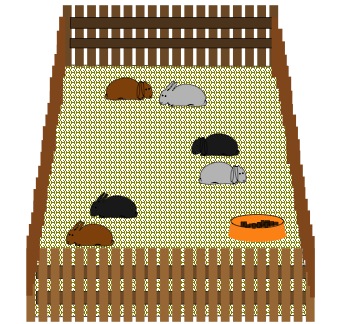Copyright © University of Cambridge. All rights reserved.
'Rabbits in the Pen' printed from https://nrich.maths.org/
Show menu
Why do this problem?
This problem is a good context for taking pupils beyond just straightforward arithmetic, by also giving them the opportunity to extend logical thinking skills.
Possible approach
A nice way to lead into the problem would be to show the class the picture of the rabbits in the pen and simply ask them to describe what they see, wihtout saying anything more yourself. Pupils will mention the different colours and different kinds of ears, and many will notice that each rabbit is different from all the others. You can use this to introduce the fact that we only have these
six different kinds of rabbit.
At this point, it would be good to use objects or symbols on the board to represent rabbits. You could print off pictures of each type of rabbit and stick them on the board, or alternatively, you could simply draw circles in the three different colours with lines to represent ears, pointing up or down. Whichever way you choose, start off by drawing just, for example, 1 brown floppy eared, 2
brown ordinary eared and 1 grey floppy eared rabbit. Ask the children to describe what they see now and begin to bring out some numerical comparisons. Some might say "there are the same number of floppy eared rabbits as ordinary eared rabbits" or "there are three times as many brown rabbits as grey rabbits". In this way, the children will become familiar with the language and will be more
confident when tackling the problems.
As they are working on the two different pens in the problem (perhaps in pairs), you might want to have counters, coloured pens etc available for the children to use. You could stop the whole group at a convenient point to discuss how they are tackling the problem. Encourage trial and improvement strategies which involve trying out a small number of one type of rabbit and building up the
other kinds of rabbits from the information given. Then, if that doesn't fit the information, trying one more of the first type of rabbit and so on. You could also invite pupils to share their methods of recording with each other - some may have devised effective short-hand symbols or letters for the rabbit types.
Key questions
How could we start on this challenge? What could we try first?
Does this fit with the other statements? . . . . if not, why not?
What could we try next?
Possible extension
Pupils could set up another situation of their own and make statements that will lead to the unique situation. They could then challenge a friend to use the statements to find out the numbers of each type of rabbit.
Possible support
You may prefer to create some slightly simpler challenges, for example:
- There are twice as many floppy ears as ordinary ears
- There are the same number of grey floppy ears as brown floppy ears and as black floppy ears
- There are the same number of grey ordinary ears as brown ordinary ears and as black ordinary ears
- There are 9 rabbits altogether
